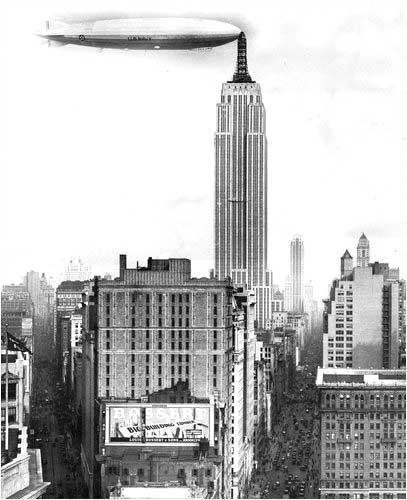Rand Building - Table of Contents
The Rand Building
"Dirigible Mooring Post"
14
Lafayette Square,
Buffalo, New York
|
Excerpt
Not Just a Perch for King Kong By Christopher Gray New York Times, Sept, 23, 2010  Keith de Lellis Gallery THE new exhibition at the Keith de Lellis Gallery, “New York: A Bird’s-Eye View,” has a striking assortment of aerial views of the city. No image is more arresting than that of the Navy dirigible Los Angeles docking at the mooring post of the Empire State Building, a giant cigarlike cylinder coming nose-to-nose with the tallest building in the world. That the photograph is a composite, a fake, is disappointing but not surprising: no airship ever docked there, and indeed the whole mooring mast concept was a bit of a stunt itself. In late 1929, Alfred E. Smith, the leader of a group of investors erecting the Empire State Building, announced that they were increasing the height of the building to 1,250 feet from 1,050. Mr. Smith, a past governor of New York, denied that competition with the 1,046-foot-high Chrysler Building was a factor. “We are measuring its rise by principles of economic investment rather than spectacular standards,” he told The New York Times. The extra 200 feet, it was announced, was to serve as a mooring mast for dirigibles so that they could dock in Midtown, rather than out in Lakehurst, N.J., the station used by the German Graf Zeppelin. Mr. Smith said that at the Empire State Building, airships like the Graf, almost 800 feet long, would “swing in the breeze and the passengers go down a gangplank”; seven minutes later they would be on the street. But the Germans, who dominated dirigible technology, had not asked for a docking station, and passenger traffic on dirigibles was still minuscule. The mast camouflaged the quest for boasting rights to the world’s tallest building, an ambition to which it seemed indecent to admit. The famous photo of the dirigible Los Angeles docking at the Empire State Building is a fake, although there were vague plans for an airship station. Dr. Hugo Eckener, the commander of the Graf Zeppelin and the world’s expert on dirigibles, said flatly that the Empire State project was not practical. Zeppelin landings required scores of ground crewmen, retaining ropes fore and aft, and even then landings were sometimes dicey. Dr. Eckener had trained the dirigible crews for the bombing raids over London in World War I. |